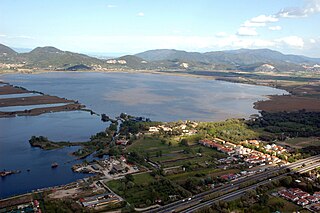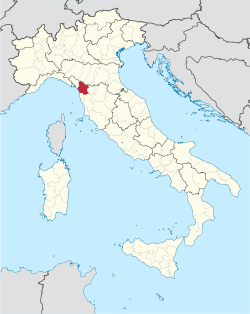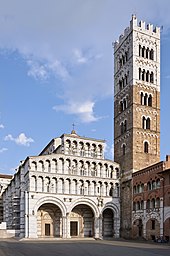
The province of Massa-Carrara is a province in the Tuscany region of Italy. It is named after the provincial capital Massa, and Carrara, the other main town in the province.

Lucca is a city and comune in Tuscany, Central Italy, on the Serchio River, in a fertile plain near the Ligurian Sea. The city has a population of about 89,000, while its province has a population of 383,957.
The Garfagnana is a historical and geographical region of central Italy, today part of the province of Lucca, in Tuscany. It is the upper valley or basin of the river Serchio, and thus lies between the main ridge of the Northern Apennines to the north-east and the Alpi Apuane to the west. The principal towns are Castelnuovo di Garfagnana and Barga.

Viareggio is a city and comune in northern Tuscany, Italy, on the coast of the Tyrrhenian Sea. With a population of over 62,000, it is the second largest city in the province of Lucca, after Lucca.

The Serchio is the third longest river in the Italian region of Tuscany at 126 kilometres (78 mi), coming after the Arno at 242 kilometres (150 mi) and the Ombrone, 161 kilometres (100 mi). By mean rate of flow, it is the second largest, smaller than Arno but larger than Ombrone.
Versilia is a part of Tuscany in the north-western province of Lucca and southern part of Massa-Carrara, and is named after the Versilia river. Known for fashionable Riviera resorts, it consists of numerous clubs that are frequented by local celebrities.

Bagni di Lucca is a comune of Tuscany, Italy, in the Province of Lucca with a population of about 6,100. The comune has 27 named frazioni (wards).

Torre del Lago is a town of almost 11,000 inhabitants, a frazione of the comune of Viareggio, in the province of Lucca, Tuscany, Italy, between the Lake of Massaciuccoli and the Tyrrhenian Sea.

The Festival Puccini is an annual summer opera festival held in July and August to present the operas of the famous Italian composer Giacomo Puccini.

Camaiore is a city and comune of 32,513 inhabitants within the province of Lucca, Tuscany, central-western Italy. It stretches from the Apuan Alps to the east, to the plains and the coast of Versilia to the west.

Forte dei Marmi is an Italian sea town and comune located in the province of Lucca, in northern Tuscany, overlooking the Ligurian Sea.

San Romano in Garfagnana is a comune (municipality) in the Province of Lucca in the Italian region Tuscany, located about 80 kilometres (50 mi) northwest of Florence and about 40 kilometres (25 mi) northwest of Lucca.

Biroldo is a very dark, brownish-red, soft-textured Tuscan blood sausage about 4 inches (10 cm) wide, with lighter-coloured chunks of meat and fat in it.

Lake Massaciuccoli is a lake in the Province of Lucca, Tuscany, Italy. Its surface area is 6.9 km2. It is located mainly in the municipality of Massarosa and partly in Torre del Lago, a civil parish of Viareggio.

Lucca railway station serves the city and comune of Lucca, in the region of Tuscany, central Italy. Opened in 1846, it forms part of the Viareggio–Florence railway, and is also the junction for lines to Pisa and to Aulla. All of these lines are only served by regional trains.

Viareggio railway station serves the city and comune of Viareggio, in the region of Tuscany, central Italy. Opened in 1936, it forms part of the Pisa–La Spezia–Genoa railway, and is also a junction for a regional line to Florence.
The 1920 Garfagnana earthquake occurred on 7 September in Garfagnana and Lunigiana, both agricultural areas in the Italian Tuscany region. The quake hypocenter was located 14 kilometres (8.7 mi) beneath Villa Collemandina. The maximum felt intensity was rated as X (Extreme) on the Mercalli intensity scale, and 6.6 on the Richter scale. It was one of the most destructive seismic events recorded in the Apenninic region in the twentieth century. Due to good news coverage, availability of official documents on the damage and abundance of recordings from surveillance stations throughout Europe, it was regarded as a first-rate case study to improve knowledge of tectonics and macroseismic analysis.

The Garfagnina or Garfagnana is an Italian breed of domestic goat from the mountainous Garfagnana area north of Lucca, in Tuscany in central Italy, from which it takes its name. It is raised in that area, in the comuni of Camporgiano, Careggine, Castelnuovo di Garfagnana, Fosciandora, Minucciano, Pieve Fosciana, Vergemoli and Villa Collemandina; in the comuni of Bagni di Lucca, Barga, Coreglia Antelminelli and Fabbriche di Vallico in the Media Valle del Serchio; and in the historic area of the Controneria, to the north-east of Bagni di Lucca. It may also be known as the Capra della Media Valle del Serchio or as the Capra della Controneria. It is probably the last remnant of the Apennine type of goat of Emilia, Liguria and Tuscany.

Lugliano is a small frazione (village) located in the municipality of Bagni di Lucca, in the Province of Lucca, Tuscany.





















